How do you usually estimate the effectiveness of your marketing efforts? And how do you define which tactic supports your sales the most?
Without a doubt, the conversion rate is one of the main KPIs you look at when estimating your advertising campaign’s success or unpaid content.
However, we all know how hard it can be to convert users.
Therefore, we prepared a list of the most effective tactics that will help you to increase your conversion rate and grow your business.
Structure of the article:
- What is the conversion rate?
- Conversion rate formula
- What is conversion rate optimization?
- Seven key tactics for increasing your conversion rate
What is Conversion Rate?
First, let us remember what conversion and the conversion rate actually are.
In digital marketing, the conversion is the completion of the specific desired goal by a website visitor. It can be signup for a webinar or a newsletter, clicking on a specific link, filling out the form, and so on. As you might have noticed, this is highly dependent on your business goals and overall marketing strategy.
There are two main types of conversions:
1. Macro-conversions
Macro-conversions are the primary goals that are completed by users: e.g., completion of the online purchase on the website, completion of the sign up for a form, completion of the lead generation form.
This type of conversions play a significant role in terms of sales goal completion.
2. Micro-conversions
In contrast to Macro-conversions, micro-conversions represent the completion of smaller goals that might not yet contribute so much to sales rather perform as a lead warmup. Examples of micro-conversions can include signing up for a newsletter, clicking on a specific link, or watching a product video.
This type of conversions help us to acquire and nurture new leads. This type of conversion helps you to understand how many leads you have within the first stages of your marketing funnel.
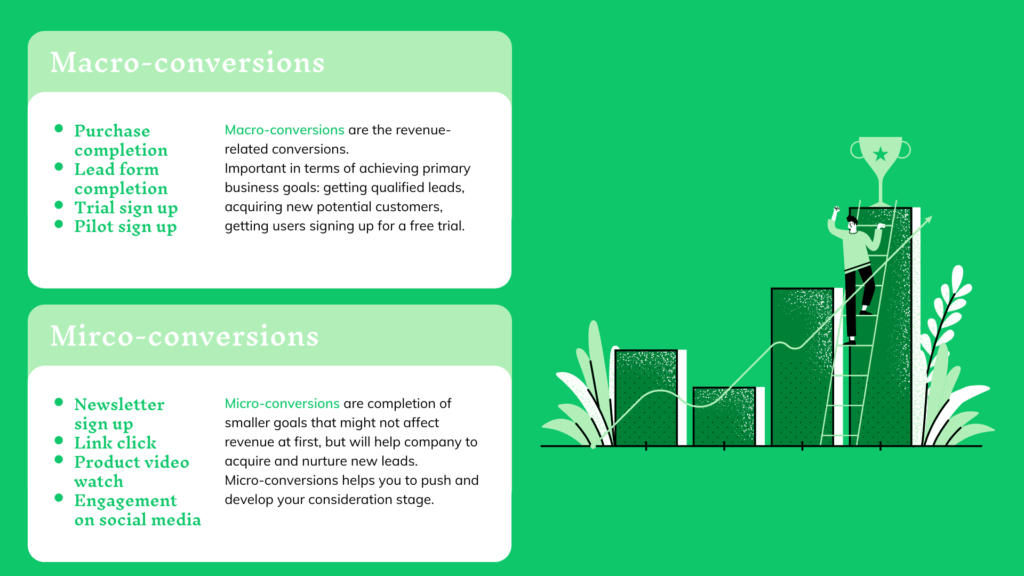
Important to understand that the definition of the macro and micro conversions may vary depending on the industry.
Conversion rate is the ratio of users who completed the desired action (the conversion) to a total number of website visitors. In other words, the conversion rate shows us the percentage of those people who converted or performed a specific desired action when visiting your website.
Important to understand that conversion does not always represent the number of new paid clients you earned with your latest campaign. It can also be any action that the user performed with your website: e.g., click on the specific button, sign up for a newsletter, download the report or template from the website. Therefore, before optimizing your conversions, it is important to clarify what you actually mean by this conversion.
Conversion rate formula
How do you calculate the conversion rate?
Very easy.
The conversion rate is calculated by applying the following formula:
Conversion rate = Number of Conversions/Total number of website visitors *100%
Many platforms calculate it for you automatically.
For example, in Google Analytics, you can see your current conversion rate within the Acquisition section.
You can find more information about the conversion rate and its common variations in our article about conversions.
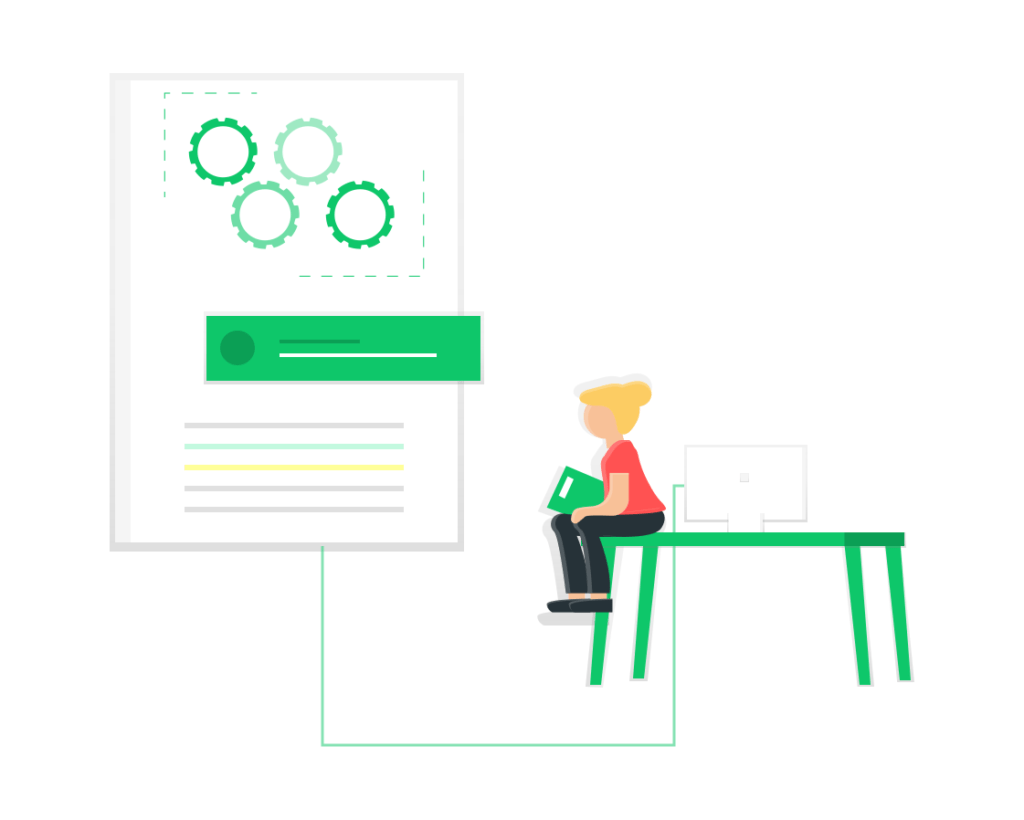
What is Conversion rate optimization?
Conversion rate optimization (CRO) is the practice that businesses use to increase their conversion rate.
This practice includes understanding users’ behaviors on the website, how they navigate through the website, what actions users perform, and the main distractors or main factors that make people leave the website without converting.
Important to understand that to ensure success and sustainability, this process should be ongoing. Some tactics might not work, while others might appear effective for your business.
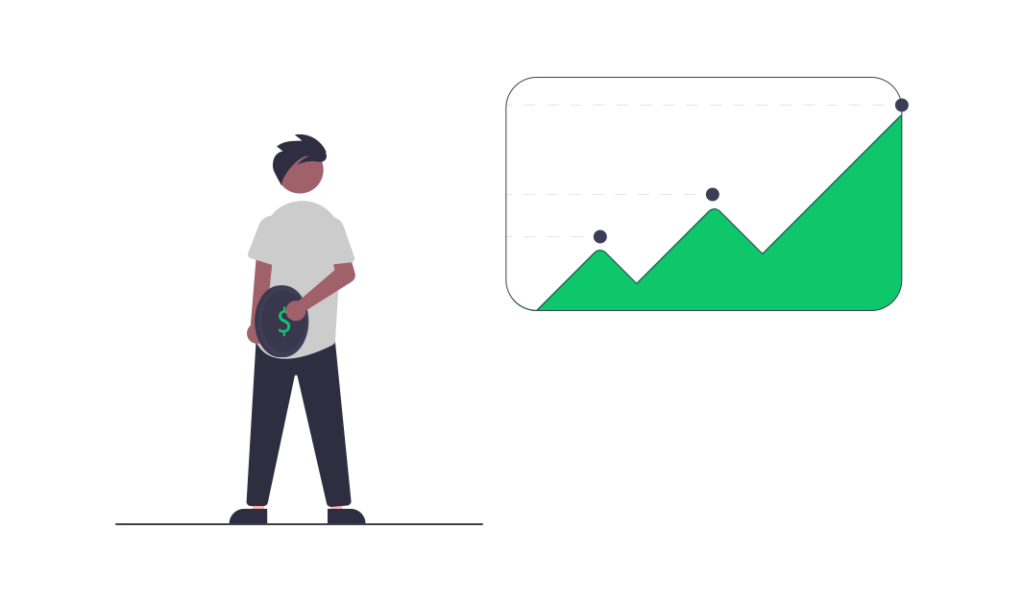
Seven key tactics for increasing your conversion rate
1. Make it very easy for the customer to convert
Think through how customers usually navigate through your website. What are the most important sections of your website users usually look at? This highly depends on your business and industry.
Ensure the potential customer can easily contact you if he has questions or is interested in your product.
Here the main rule is to keep it simple. Make it clear for the customer what actions he needs to perform to find the desired product, get more information about it, and finally decide about the purchase. The more intuitive your navigation is, the higher chances of conversion you get.
Define potential distractions and eliminate them.
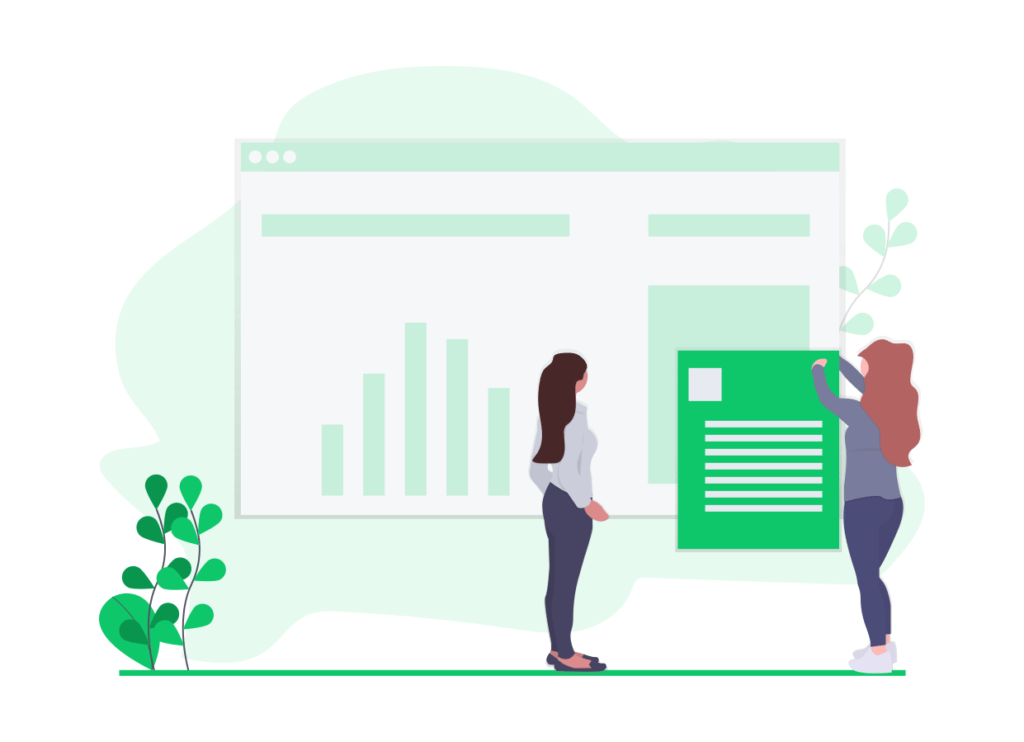
2. Define potential pain points
Define what could be potential reasons for customers bouncing. In other words, you need to detect where you usually lose your customers.
This is where such web analytics solutions as Google analytics comes into play.
With Google Analytics, you can easily define how long customers usually stay on a specific page, which pages they visit most often, and the top exit pages.
Moreover, with the function “Behavior flow”, you can easily define which pages have the highest drop-off and where you lose most of your customers.
After identifying the pages with the highest bounce rate, drop-off rate, and lowest average time on the page, you can progress on their improvement and optimization.
Analyze what could be the reasons for bad performance.
- Is the content on the page relevant?
- Does the page have clear navigation?
- How fast does the page load?
- Does it answer customer’s questions?
Another great analytics tool is hotjar. This tool can help you to understand what exactly your customer is doing on your website: where do users click, where do they get stuck, and how they navigate through your website.
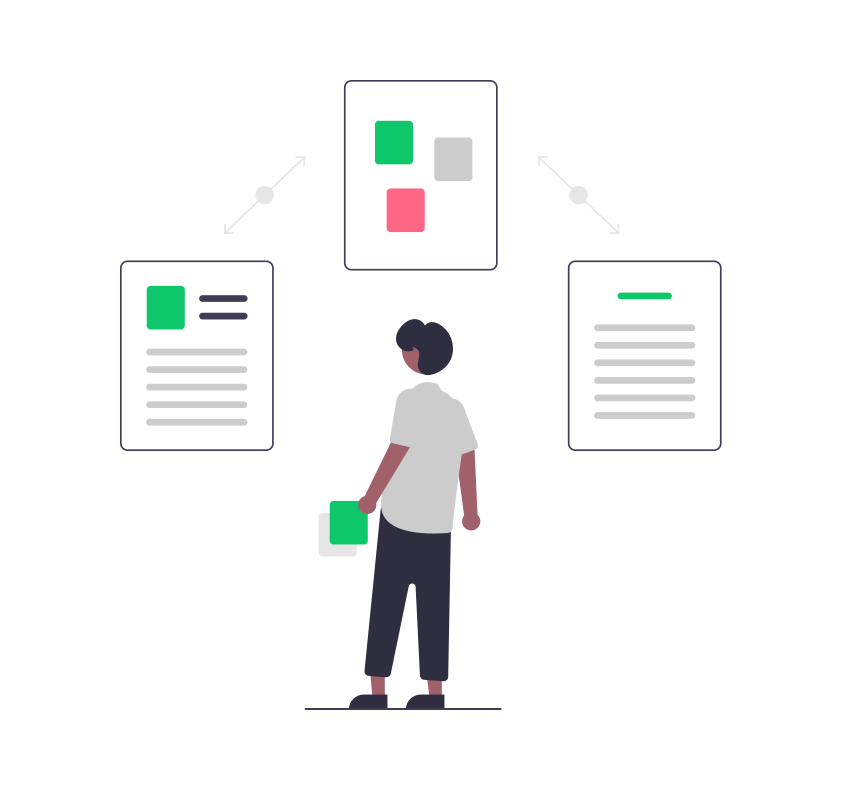
3. Provide social proof
Social proof is one of the most effective tactics of CRO.
To facilitate a higher conversion rate, make sure you provide testimonials, reviews, case studies, success stories, and key partnerships on your website.
Testimonials play a significant role in the consideration and conversion stages of the marketing funnel. Therefore, it is important to place it on your homepage and make it very easily visible and accessible.
Reviews can also significantly influence your conversion rate.
Often users make their final decision after reading the recent reviews about the product or service. Hence, having good reviews can significantly boost your conversion rate.
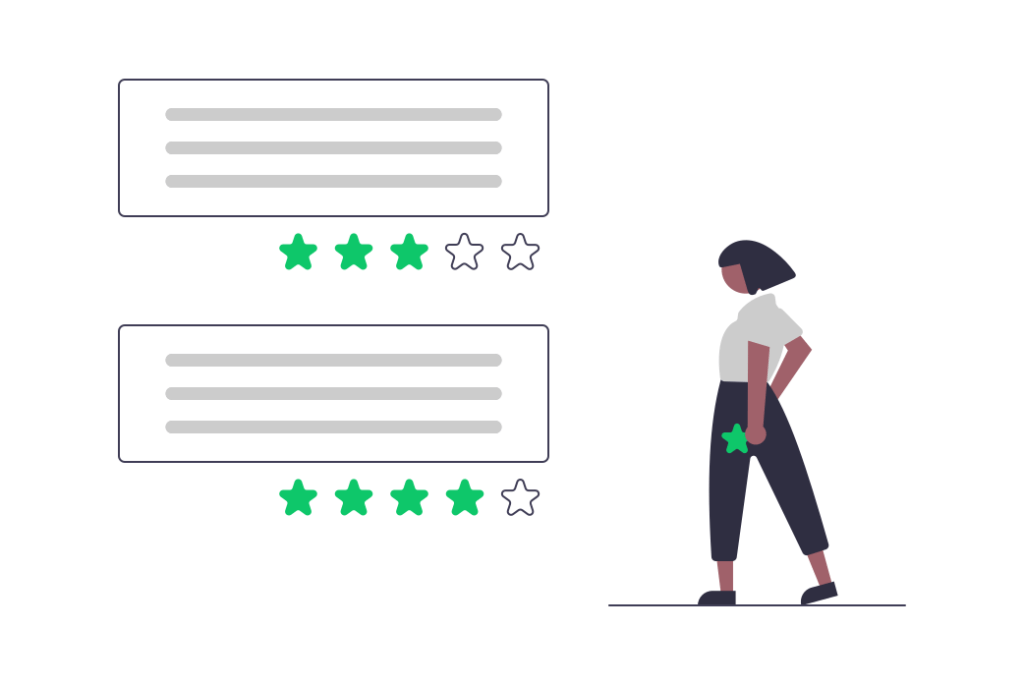
4. Add a pop-up to your website
Although many people think it’s irritating and annoying, statistics show that pop-ups can increase conversion rate by up to 9%. On average, the pop-ups conversion rate equals 3.09%. This means that if your website gets around 1000 visits per month, implementing a pop-up can help you generate around 39 conversions (for example, newsletter subscribers) each month. Not bad at all!
If you want to try it out, don’t forget about the main elements of a good-performing pop-up:
- Clear and catchy headline
- Convincing image
- Valuable give away or magnet for a user
- Possibility to close the pop-up
To sum up, if made right, pop-ups can help you to boost your conversion rate. Make it simple and relevant to your messaging.
5. Think through your CTAs
Make sure you have relevant, clear, and engaging CTAs.
Although it might seem not that vital, change in CTAs can significantly influence your conversion rate.
Therefore, make sure that the CTA is relevant to the content you provide.
For example, in case you want to educate your readers to use such CTAs as:
- Become an expert at Digital Marketing by signing up for our newsletters
- Learn more about the most recent technologies
- Stay tuned by signing up for our newsletters
- Download our report to learn more about Ethics in AI
You can also use Fear of missing out (FOMO) to engage clients to perform a specific action:
- Don’t miss the chance to try out our new offer
- Don’t wait! Sign up now
- Use the chance to learn more about Machine learning
Let’s now assume we want to drive more sales. In this case, we can use the following CTAs:
- Shop now
- Buy now
- Reserve now
- Book now
As you can see, the choice is huge! Conducting AB testing can help you to define the best performing CTAs for your audience.

6. Add a chatbot to your website
According to HubSpot, around 47% of consumers would be open to making a purchase using a chatbot.
Here it is important to mention that a lot depends on the industry.
According to Chatbots Life, the following five industries are profiting the most from the implementation of chatbots: real estate (28%), travel (16%), education (14%), healthcare (10%), and finance (5%). Therefore, if you are working in one of these industries, you can try this tactic to increase your conversion rate.
However, even though your industry might not be on this list, you can still give it a shot.
Many chatbots platforms provide free trials where you can test the tool within a few weeks.

7. Improve your Web vitals
Last but not least, make sure you optimize your Web vitals.
Web vitals are a set of metrics that help marketers ensure good website performance and a better user experience. Tracking this KPI helps you to define the “health-score” of your website.
At the moment, Web vitals measures three main elements of the website performance:
- Website loading performance
- Interactivity
- Stability
You can learn more about them in our article about key SEO KPIs.
Important to understand that each of these metrics plays a significant role when it comes to converting users.

These were our tips on how to increase your conversion rate!
We are happy to support you on your way to becoming more data-driven.
Download our free ebook and learn the fundamentals of data-drivenness with 17 marketing KPIs!